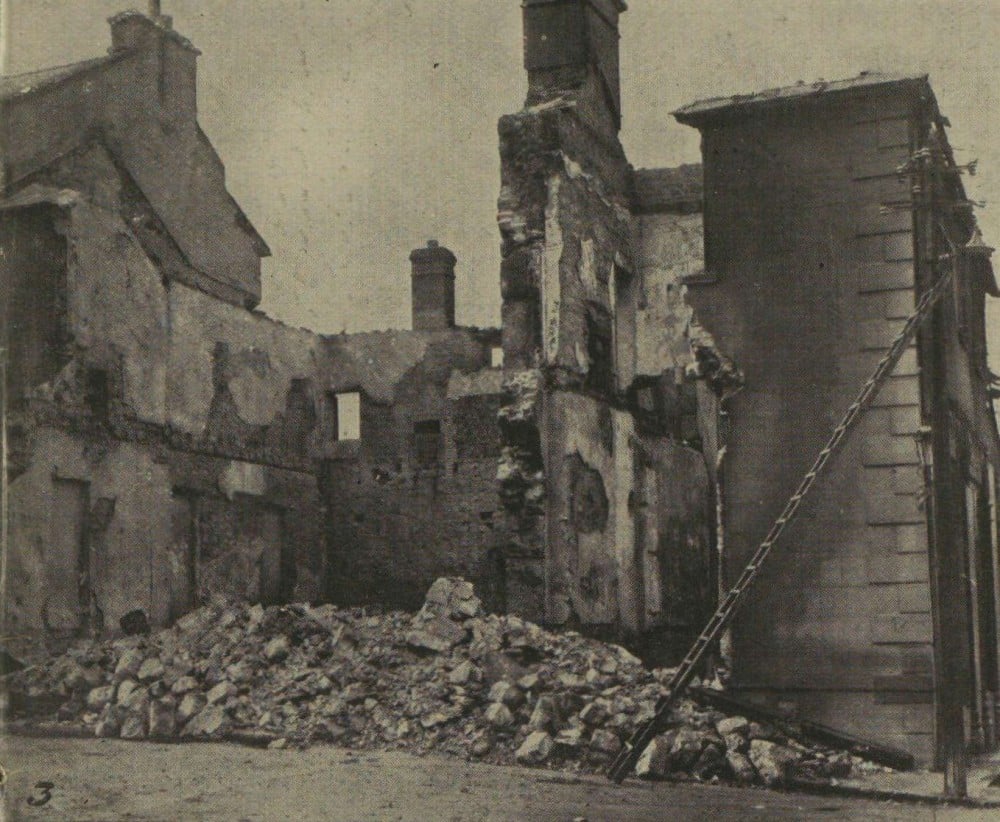Tuam ‘sacked’ by RIC as reprisal for murdered constables
Galway, 21 July 1920 - A night of terror and destruction perpetrated by the Royal Irish Constabulary (RIC) in Tuam, in Co. Galway has caused damage to property estimated to be upwards of £100,000.
The sack of Tuam was a reprisal for the killing of two policemen yesterday afternoon. Constables Patrick Carey and James Burke were shot dead when the police motor car in which they were travelling was ambushed three miles outside the town. The constables were returning from the Galway Assizes when they were attacked by a group of men understood to number between 40 and 50. Carey and Burke were shot jumping from their car while two other policemen travelling with them were overpowered, disarmed, blindfolded and sent walking in the direction of Tuam where, a short time later, they reported the matter at the barracks.
The bodies of the two dead constables were waked at the police barracks and towards dawn their colleagues began an awful rampage through the town. During these dreadful scenes the Town Hall was badly damaged, houses and businesses were burned, shops were looted and shots were fired on the streets.

A wrecked property in Tuam 'not unlike a shattered dwelling house in one of the Flanders battle areas' (Image: Illustrated London News [London, England], 31 July 1920)
Remarkably, nobody lost their life. Many families are believed to have huddled close together on stairways or towards the back of their houses reciting the rosary in an attempt to protect themselves.
There were a number of lucky escapes. The Canney family were sleeping upstairs when their drapery shop beneath them was set alight. The terrified family had to fight their way down a burning staircase in their night attire, only to find their front door barred with rifles. They eventually made their way to safety by going back through the burning house, up the stairs and out onto the roof where they escaped over the top of a neighbouring house.
At one point during the unrest, P.J. Lynch, a boot maker, and his daughter left their house and were making their way down Shop Street when they encountered a policeman who allegedly raised a bottle to his lips before firing his gun in their direction.
It is also being reported that local Sinn Féiners were arrested and might have been shot if Constable Colleran and Head Constable Bowles had not intervened on their behalf.
Reaction
The Archbishop of Tuam, Thomas Gilmartin, has written to the
commander of the British forces in Ireland, General Nevil
Macready, looking for answers. Dr Gilmartin described the killing
of the two RIC constables as a ‘dastardly crime’ which
he condemned, but he equally took issue with the police response.
They had, he said, ‘raided the town almost from end to end.
They burned our beautiful town hall to the ground; they set fire
to one large shop… they tried to set fire to at least four
other shops, and they ruthlessly broke plate-glassed windows.
Shots were fired into several houses, and a bomb was thrown into
an upper room of at least one house.’
He continued: ‘You might imagine the state of terror and indignation that exists today in what was yesterday a peaceful and prosperous town, where the relations between police and people were as cordial as could be expected. I hope you will see that a sworn inquiry is opened immediately with a view to bringing all the culprits to justice and making reparation to the town as far as such is possible.’
The Freeman’s Journal has likened the sack of Tuam to the German actions in Louvain and Aerschot during the Great War. The paper has also urged that swift and drastic punishments be meted out to the perpetrators, but is not hopeful given the precedents that have occurred in the towns such as Thurles, Arklow and Fermoy over the last year.
[Editor's note: This is an article from Century Ireland, a fortnightly online newspaper, written from the perspective of a journalist 100 years ago, based on news reports of the time.]





















